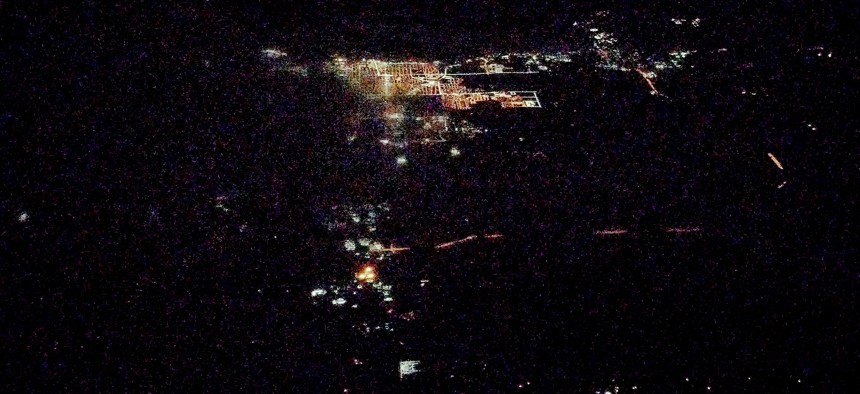The Creepy Beauty of Flying Over North Dakota Fracking Country at Night

Up above Williston, North Dakota on Tuesday night. Michael Grass / RouteFifty.com
Despite shifts in the global energy market, see how this remote part of the northern Great Plains continues to shine bright from above.
FLYING ABOVE WILLISTON, N.D. — It’s sometimes very easy to identify certain cities at night. Chicago, for instance, which hugs Lake Michigan and has a sprawling and glowing street grid with major diagonal arteries heading in and out of the Loop, is hard to miss when you’re flying across the nation’s northern tier, like I was on Tuesday flying from North Carolina to Seattle.
Madison, Wisconsin, situated on an isthmus between two lakes, is another easy one to spot. But once you pass Minneapolis, the vast expanse of the northern Great Plains opens up and identifiable cities are harder to come by though Fargo and Minot in North Dakota, stand out amid the emptiness.
But continuing westward, you’d be forgiven if you thought some massive metropolis you’d never heard of had somehow risen out of nowhere in rural northwestern North Dakota.
It doesn’t look like most cities. There isn’t an easily identifiable street pattern or even suburban sprawl. But there’s an expansive, though seemingly unorganized, network of illuminated structures that spreads out over hundreds of square miles below.
Many of those lights twinkle as if they were stars in far-off galaxies. Some of the lights flicker with a dirty orange hue. It’s a peculiar landscape to take in from 35,000 feet at night and there’s a creepy beauty to it all.
What it is? This is the heart of North Dakota’s fracking country, which shines so bright after sunset that the built environment of energy infrastructure looks like a giant population center from outer space.
Plenty has been written in recent years about the impacts of the Bakken oil boom in North Dakota, from the “man camps” of Williston and Watford City to the risks that oil trains pose when they pass through populated areas hundreds of miles away.
Most recently, the Dakota Access pipeline protests by the Standing Rock Sioux tribe and their allies near Bismarck put a spotlight on how the energy sector impacts communities along the route of the infrastructure that carries oil and gas out of North Dakota to far-away refineries, ports and distribution facilities.
While North Dakota’s Bakken boom has eased as the global energy market has undergone significant shifts in recent years, North Dakota’s drilling industry hasn’t pulled up stakes. In many ways, it’s physically changed the landscape. And you might not fully appreciate the forces at play in this remote corner of North America until you fly over it at night.
RELATED on Route Fifty:
Michael Grass is Executive Editor of Government Executive’s Route Fifty and is based in Seattle.
NEXT STORY: Calif. Regulators vs. Uber's New S.F. Deployment; Baltimore Mayor’s Hand-Delivered Letter to Trump






